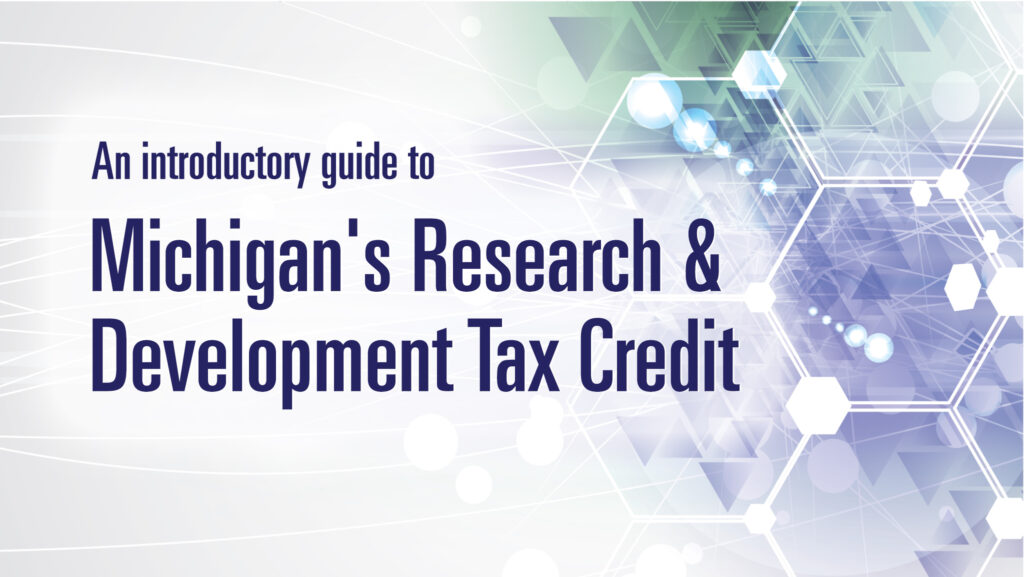
Michigan has taken a bold step forward to support businesses investing in research and development (R&D). With the passage of Public Acts 186 and 187 of 2024, the state has introduced a new R&D tax credit, effective for tax years beginning on or after January 1, 2025. This incentive is designed to encourage innovation by providing financial relief to businesses engaged in R&D activities within Michigan.
Who Qualifies?
The R&D tax credit is available to two main categories of businesses:
- Corporate Income Tax (CIT) taxpayers: Companies subject to Michigan’s CIT can claim the credit for qualifying R&D expenditures.
- Flow-through entities: Businesses structured as partnerships, LLCs, or S corporations that are subject to Michigan income tax withholding (but not the CIT or Michigan Business Tax) may also qualify.
To be eligible, businesses must demonstrate that their R&D expenses in a given tax year exceed their average annual R&D expenses over the previous three years.
What Expenses Qualify?
Michigan’s R&D credit is based on “qualified research expenses” as defined in Section 41(b) of the Internal Revenue Code. However, only expenses incurred for research conducted within Michigan count toward the credit.
How the Credit is Calculated
The amount of the R&D tax credit varies depending on the size of the business:
- Businesses with fewer than 250 employees:
- 3% of R&D expenses up to the base amount
- 15% of R&D expenses above the base amount
- Maximum credit of $250,000 per taxpayer
- Businesses with 250 or more employees:
- 3% of R&D expenses up to the base amount
- 10% of R&D expenses above the base amount
- Maximum credit of $2 million per taxpayer
Note: The base amount is defined as the average annual amount of qualifying research and development expenses incurred during the three calendar years immediately preceding the tax year for which the credit is being claimed. The Michigan Department of Treasury has clarified that if expenses were only incurred in one or two of those years, the average is based on those years only. Short taxable years will be treated as full years, and no annualization is required. For businesses with no prior R&D expenses, the base amount is zero.
Additionally, businesses collaborating with a Michigan research university can claim an extra 5% credit on the portion of their expenses tied to that partnership, capped at $200,000 annually.
Claiming the Credit
To claim the R&D tax credit, businesses must first file a tentative claim with the Michigan Department of Treasury. The deadlines are:
- April 1, 2026 for R&D expenses incurred in 2025
- March 15 of the following year for expenses incurred in subsequent years
Claims must reflect actual, not estimated, expenses. The total amount of R&D tax credits issued statewide is capped at $100 million per year, with $25 million reserved for small businesses. If claims exceed this cap, the credit will be prorated among eligible claimants. Treasury has stated it will make every effort to publish the proration notice before April 30 each year. The Michigan Department of Treasury has also clarified that no taxpayer-specific information will be included in the proration notice, although some information will be shared with the legislature as required by law.
Important Considerations
- The credit is refundable, meaning businesses can receive a cash refund if the credit exceeds their tax liability.
- Businesses cannot transfer or assign the credit to another entity.
- Disregarded entities are not eligible for the R&D credit. The Michigan Department of Treasury has included a definition of “flow-through entity” in its guidance to clarify eligibility. For unitary business groups (UBGs), a single credit claim must be filed aggregating the eligible expenses of all members. Additional guidance on this topic is expected in a forthcoming Revenue Administrative Bulletin (RAB).
- The definition of “employee” aligns with Section 3401(c) of the Internal Revenue Code. The Michigan Department of Treasury may issue FAQs to clarify how employee counts should be determined for withholding-based credits.
- The Michigan Department of Treasury has issued a notice regarding the new Research and Development (R&D) credit, as well as a response to comments submitted by stakeholders in April 2025. These documents offer additional clarification on base amount calculations, short taxable years, UBGs, and more. Businesses are encouraged to consult with their tax advisors and stay informed as Treasury releases further guidance.
Why This Matters
Michigan’s new R&D tax credit is a game-changer for businesses looking to invest in innovation. Whether you are a startup developing cutting-edge technology or an established company enhancing your products, this incentive can help offset costs and fuel growth. By encouraging more businesses to conduct R&D in Michigan, the state is reinforcing its reputation as a hub for technological advancement and industry leadership.
For more information on incentives available to Michigan businesses, explore our related posts on the Business Development Program and the Industrial Facilities Exemption.
To learn more about the R&D industry in the Ann Arbor region, visit this page.